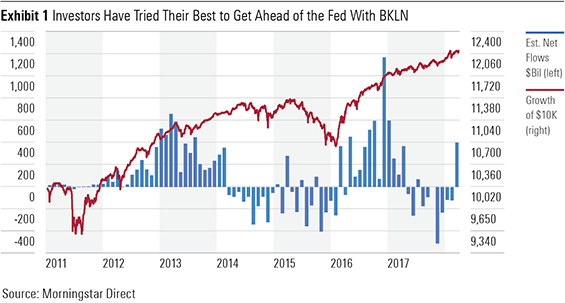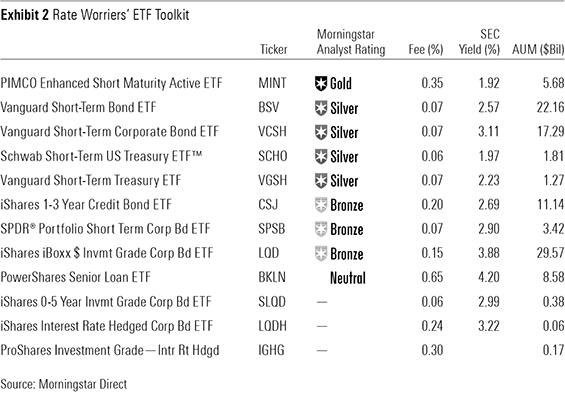Fear of Rising Rates Can Sow the Seeds of Bad Behavior
It may be better to do nothing than to try to reposition for rising rates.
Rising interest rates can hurt investors’ fixed-income portfolios. Investors have been fretting over rising rates for years now. Many have been trying to reposition their portfolios to shield against the negative effects of higher rates. In some cases, their attempts to do so have yielded results that pale in comparison to a do-nothing approach.
In this article, I will examine the case of
PowerShares Senior Loan Portfolio BKLN BKLN is arguably one of the most popular senior loan ETFs. Senior loans have little sensitivity to interest-rate risk as their coupon payments float with prevailing interest rates and typically reset once a quarter. As a result, these loans' duration tends to hover near zero, making them ideal to insulate losses from rising rates. Consequently, as investors have become increasingly concerned with rate hikes, senior loan funds such as BKLN, which was launched in 2011, have garnered a lot of attention.
In the intervening years, investors, on average, haven’t been very successful in using BKLN to shield themselves against the effects of rising rates. The fund’s cash-flow-weighted return from its March 2011 inception through March 2018 was about negative 1.6%. Meanwhile its time-weighted return was 3.1%. The difference is, in part, evidence of poor timing decisions.
One such instance of bad timing occurred as chatter of a rate hike intensified in 2015. That March, the Federal Open Market Committee stated that “[l]abor market conditions have improved further, with strong job gains and a lower unemployment rate.” Investors believed this was one of many signs pointing to an imminent lift-off. That April, BKLN raked in $300 million of inflows, as shown in Exhibit 1. Unfortunately for those investors who poured money into BKLN in anticipation of a rate hike, the FOMC’s April statement struck a different tone, noting that economic growth had slowed during the winter months. Furthermore, soon after the FOMC’s April press release, senior loan investors got caught up in the high-yield sell-off that was instigated by plummeting energy prices. During the months that followed, BKLN saw its value decline and investors headed for the exits.

Of course, the Fed ultimately hit the launch button near the end of 2015. This episode illustrates not only how difficult it is to predict changes in rates, but also the countless factors—energy prices in this case—that may influence this (or any) fund’s performance. All these factors are simply impossible to forecast. Equally important, it highlights another piece of evidence indicting investors as their own worst enemies.
However, it does not necessarily mean investors are doomed in the face of interest-rate risk. Though difficult, it may still be prudent to manage this risk. Following are some instruments that may help mitigate the effects of rate increases on investors’ fixed-income portfolios.
Cash Cash is the mother of all hedges. The most conservative approach for investors concerned about interest-rate risk is to liquidate some of their fixed-income holdings and raise cash. While cash takes all interest-rate risk out of the equation, it has notable weaknesses. Most importantly, after moving into cash investors must decide when to redeploy it. Raising cash and then putting it back to work in such fashion is effectively market-timing. Uncertainty, one of the risks that the investor sought to avoid by raising cash in the first place, comes back into the equation when they look to put it back to work. This simple solution is not free either. Whether selling current positions at a gain or loss, there will be transaction costs. Also, investors can incur capital gain taxes by selling at a gain. Finally, cash currently offers practically no return. In fact, cash will earn a negative real return in today's rate environment.
Short-Term Bonds
Short-term bond ETFs typically offer higher yields than cash and provide a low-cost path to dial back interest-rate risk.
There are higher-yielding short-term bond ETFs, though they assume additional credit risk. Specifically, investors might consider Silver-rated
While index-tracking ETFs offer advantages such as low costs and tax efficiency, they are, well, passively managed. These “hands-off” vehicles pose a few challenges. Because the composition of their portfolios is largely dictated by debt capital market activities, they steer toward to the most active part of the yield curve and/or sector they aim to track. Accordingly, these funds can have concentrated positions on points in the yield curve that leave them more susceptible to losses when rates rise.
Gold-rated
Interest-Rate Hedged Bond ETFs
Like a typical bond ETF, interest-rate hedged bond ETFs track an index. However, the funds employ rate-hedging mechanisms—such as shorting Treasury futures—to all but eliminate the fund’s interest-rate risk.
While these funds do reduce interest-rate risk, they tend to behave like stocks. In fact, their monthly return correlation with S&P 500 from June 2014 to March 2018 was 0.65. Investors tend to hold bonds to diversify equity as bonds tend to go up, when stocks go down, and vice versa. However, these rate-hedged ETFs diminish the diversification benefit of bonds, as exemplified by their relatively greater correlations to stocks versus their unhedged counterparts. Also, these funds may be costly to trade, given their small asset bases and low trading volume.
Conclusion None of the various rate-hedging strategies I've described here is particularly easy to implement in a low-cost manner. Each comes with its own caveats. The most important of those warnings being that history has proven that market-timing is impossible. While it is important to understand the broad array of tools for combatting interest-rate risk, the best weapon for defending one's portfolio might be time. As rates rise, investors and the funds they own will reinvest dividends, coupon payments, and the proceeds of any maturities at the prevailing—and presumably higher—rates.

- source: Morningstar Analysts

Disclosure: Morningstar, Inc. licenses indexes to financial institutions as the tracking indexes for investable products, such as exchange-traded funds, sponsored by the financial institution. The license fee for such use is paid by the sponsoring financial institution based mainly on the total assets of the investable product. Please click here for a list of investable products that track or have tracked a Morningstar index. Neither Morningstar, Inc. nor its investment management division markets, sells, or makes any representations regarding the advisability of investing in any investable product that tracks a Morningstar index.


/cloudfront-us-east-1.images.arcpublishing.com/morningstar/T2LGZCEHBZBJJPPKHO7Y4EEKSM.png)
/d10o6nnig0wrdw.cloudfront.net/04-18-2024/t_34ccafe52c7c46979f1073e515ef92d4_name_file_960x540_1600_v4_.jpg)
/d10o6nnig0wrdw.cloudfront.net/04-09-2024/t_e87d9a06e6904d6f97765a0784117913_name_file_960x540_1600_v4_.jpg)